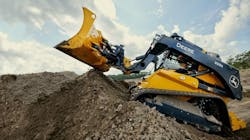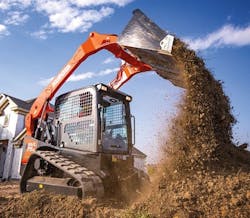Asset management can sometimes feel like playing Whack-a-Mole. Unscheduled maintenance, mixed brands, surprise repairs, fuel and consumable costs that seem to fluctuate with whatever the headline of the day is—it is a balancing act trying to keep costs in line and reasonably predictable.
OEMs acknowledge the challenges of asset management. Today’s compact track loaders make owning and operating one of the handiest machines on any job site manageable with more DIY support, technical assets, and easy-access machines.
How to spec a compact track loader
When it comes time to add a new CTL to the fleet, resist the temptation to spec something with more bells and whistles than needed. Be honest about what size and type fits the fleet. The goal is to improve productivity without creating additional costs by purchasing a CTL that poorly fits the need.
Fuel consumption management starts with horsepower. Buying more horsepower than required drains the fuel budget faster because bigger machines use more diesel to start working and while idling.
How can the Bobcat electric CTL cut costs?
Vertical versus radial lift. After sizing the horsepower, lift configuration is the next fit factor. Vertical-lift CTLs have higher rated operating capacities (ROC), good for loading trucks and handling material. Radial-lift machines have a mid-height reach but greater bucket breakout and lift-arm force, all good for ground-level work such as digging and dozing. To combine the benefits of both the vertical- and radial-lift configurations, JCB’s iconic single-arm 3TS-8T with the industry’s only telescopic boom is a sound choice. JCB’s side entry door also makes it easier and safer for operators to access the cab.
The CTL’s footprint affects transportation as well as performance. Consider trailer dimensions in addition to worksite conditions. Balance the temptation of buying a machine to suit current circumstances with the need to perform on the jobs at hand. No matter how many work modes a smaller CTL might offer, asking it to perform a heavier machine’s work will quickly result in repair costs and undue labor hours.
Tracks and undercarriage design continue to be reengineered for different applications. An automatic track tensioning system such as Gehl’s IdealTrax keeps the tension precise and is one less task to pay the operator to monitor.
Pairing current attachments with the new CTL’s power, hydraulics, and physical configuration adds capabilities that have already been paid for. Consider a high-flow hydraulic option for attachments that need extra power instead of overworking the standard hydraulic package.
CTL maintenance costs
Manufacturers and dealers offer options that make it more convenient for fleet managers to maintain equipment in-house.
Caterpillar’s Customer Value Agreement (CVA) promises that parts are delivered on schedule with instructions for maintenance. Cat says that if maintenance and repair parts are not available when needed, it will issue a prepaid credit up to $1,000. The Cat CVA helps manage some of the current supply chain pressures.
Deere recently released its Deere Protect Parts & Fluids Plan that supports the company’s Deere Protect service plan. The Deere Protect Parts & Fluids Plan answers customer requests for machine warranties and assurances, while enabling them to perform the maintenance labor with their in-house technicians.
The availability of service kits is another option for managing maintenance. Ordering a packaged kit such as those sold by Wacker Neuson ensures that the correct parts and supplies are gathered the first time, reducing the possibility of the return/reorder cycle that adds to maintenance downtime. Cat also offers a broad range of self-service common repair options, packaged with everything a customer needs to do the work in their shop or in the field.
Service access to major components on the JCB CTLs takes just a few minutes to tilt the entire cab forward. This means simpler servicing and less downtime.
Operator costs to watch
CTL operator behavior has a direct influence on daily cost management. An operator who pays attention to error codes can save a fleet owner big money. Preventive maintenance and condition monitoring are vital, but if the operator chooses to ignore or zero out error codes, they eliminate the shop’s efforts. In a survey of 80 machines owned by a large fleet, Caterpillar analysts listed the top fault codes they found. Cat then compared the cost to fix the source of the fault code before the component failed and after it failed:
Takeuchi says that a good operator can help control compact track loader costs by practicing preventive operation techniques, especially when it comes to track and undercarriage wear. For example, when working in rough or loose conditions such as gravel or sand, operators should make gradual or three-point turns instead of counter-rotating to keep ground material from building in the undercarriage. Riding over curbs or construction debris can damage and weaken CTL tracks, especially if water invades the track’s embedded steel cables. Operating the CTL at a slower speed on hard surfaces such as asphalt will lengthen the track service life. Undercarriage components such as roller idlers and tracks will last longer when the loader is operated up and down on slopes, not across (sideways.)
Technology reduces TCO
As with other machine categories, CTL cost strategies include technologies that give fleet managers greater precision and productivity.
Deere 333G SmartGrade has fully integrated 3D grade-control capabilities. Touch a button, and the Deere CTL switches to dozer mode. Fewer passes and better material control mean less waste and labor costs.
Caterpillar has remote automation for its D3 CTL line. Cat Command puts the operator outside the vehicle, important for hazardous environments. Cat is offering two configurations: a line-of-sight operation using a lightweight console, and non-line-of-sight operation using a remote command station. By allowing the user to control the machine from a safe location, Cat Command is for high machine productivity in complex operating environments such as working with hazardous waste, demolition, and confined spaces. Similarly, Bobcat’s MaxControl Remote Operation lets the operator control the vehicle with a smartphone.
More CTLs now offer field telematics. Kubota has extended its KubotaNOW telematics to the SVL97-2 CTL, complete with the myKubota app that connects operators, owners, and fleet managers via their mobile devices. The myKubota app pushes notifications to an Apple Watch.

